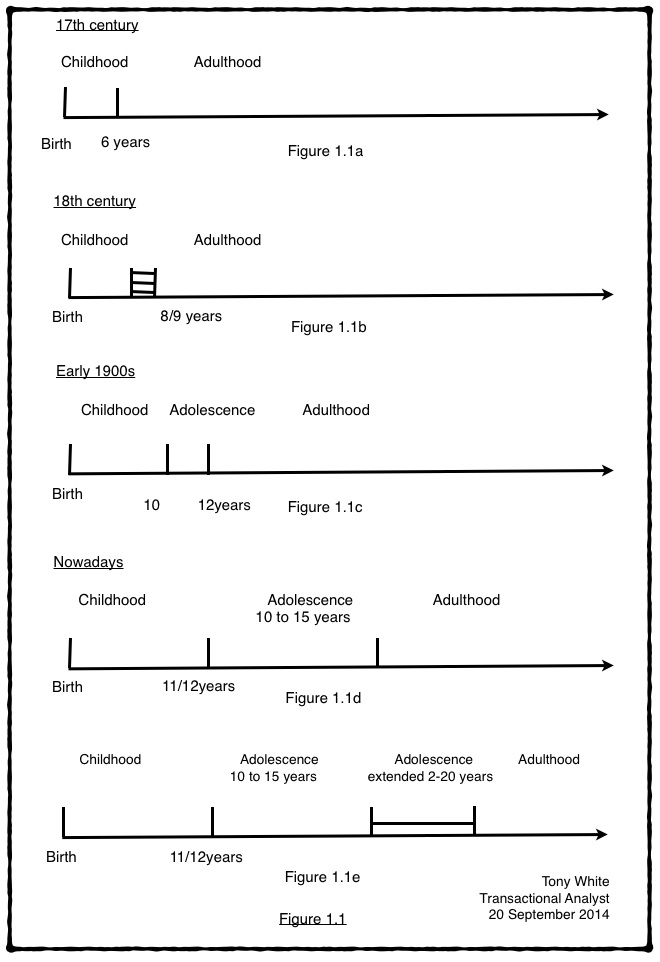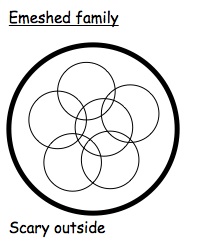In 17th century Europe there was no concept of adolescence. In the 18th century adolescence still did not exist but childhood was pushed out a few years to about 8 or 9 years of age. This happened due to the beginnings of education for children. It wasn’t until the early 1900s that people first began to develop the idea of a stage of development between childhood and adulthood and the idea of adolescence was born. In those days it was about 2 years long until now (in westernised societies) where it has increased to 10 to 15 years.
The goal of adolescence is a period where the child is transitioning from childhood into adulthood. It is meant to be where the child psychologically (and physically) leaves home. They stop being psychologically depends on the parents and develop their own psychological independence.
When this goes awry we can end up with figure Figure 1.1e. This shows a neurotic state where the child unsuccessfully does not complete the adolescent stage of development and hence it is extended. This can range from a couple of years to 20 years or even a lifetime. The person never develops a sense of their own psychological independence. This is of interest to counsellors as a whole series of problems can develop which keeps the adolescent psychologically dependent on the parents.
Drug issues
Mental health problems such as anxiety and depression
Psychosis
Suicidality
Eating disorders
Chronic unemployability
Obsessive involvement in an activity like a sport or internet gaming
These can be used by the teenager and the family to stop the teenager psychologically and perhaps physically leaving home. If this is the case the therapists needs to recognise it as such, as it obviously has a major impact on the counselling that is done. It should be noted that this is only the case sometimes. Teenagers can have drug use problems and mental health problems where it is not a leaving home problem.
These type of difficulties can result from the emeshed family structure
Emeshed family
The diagram shows the family members represented by the circles. In this family there is a very clear boundary between the inside of the family and the outside and the member have a sense of closeness and belonging but it is overly so. There is a script belief by the family, “Don’t trust” others (outside the family). There can be paranoid beliefs about non family members. “Us and them” thinking. The world outside the family is a scary and dangerous place and you can only trust family is their ethos.
Group think creates self perpetuating beliefs. Along with the introjection of beliefs particularly about others. This can result in fighting with others out side the family. Neighbourly disputes over fences or barking dog. Family feuds use the group dynamics of the combat state which can foster an emeshed family structure.
There can be faulty thinking – grandiose delusions about the specialness of the family or one member may be identified as special due to what is believed to be exceptional ability (sport, music academic), appearance, power, wealth and so on,
Family gatherings such as birthdays, holidays, christmas and so forth occur regularly and non attendance is viewed in a very dim light.
There can also be (but not always)
Infantalization of the children
1. Excessive contact – sleeping together, working together, socialising together
2. Prevention of independent behaviour
3. Parental – system control. Intolerant of variation or deviation of the members where members do not behave how they are supposed to. A child who refuses to eat dinner, or performing poorly at school or a parent displaying anger, power being challenged. The response to correct variations are swift and intense by other family members.
Potential problems resulting form this structure
Relationship problems – Spinsters and bachelors. Children may have a series of failed relationships that never work. No one is ever good enough for me or they all have some bad point that negates them as a potential partner. Maybe a short dysfunctional marriage may occur. A long term affair with a married man is another possibility (ie selecting an unavailable partner). When these relationship end where do they go then? Go back to the family of course.
When marriage occurs one marries the individual person and also marries their family structure all their attachments and relationships as well. The family structure and attachments were there long before the potential spouse came along and these things tend to be inert and do not readily change. Indeed in an emeshed family they are very resistant to change. If one is marrying into an emeshed family structure they better get used to the idea and it will take them a long time to be fully accepted into the family structure. Sometimes they never are and will always seen as an outsider to some extent.
People from an emeshed family can marry to get out and away. They see it as one of the few ways to get out of an oppressive family system especially when the newly weds geographically move away from the original family unit. The family will use all sorts of mechanisms to stop this happening such as financial ties, gifts, emotional black mail and so forth.
Other problems that can result from an emeshed family
School phobia
The child who is aggressive or unpopular to his peers ends up isolating self
Enuresis & encropesis = cannot stay away from home over night with out complications and embarrassment
Paruresis
Anxiety disorders – agoraphobia, panic attacks, means of travel such as a fear of flying or public transport. Any kind of anxiety that makes movement away from the home or family difficult can have some of its basis in the emeshed family structure.




